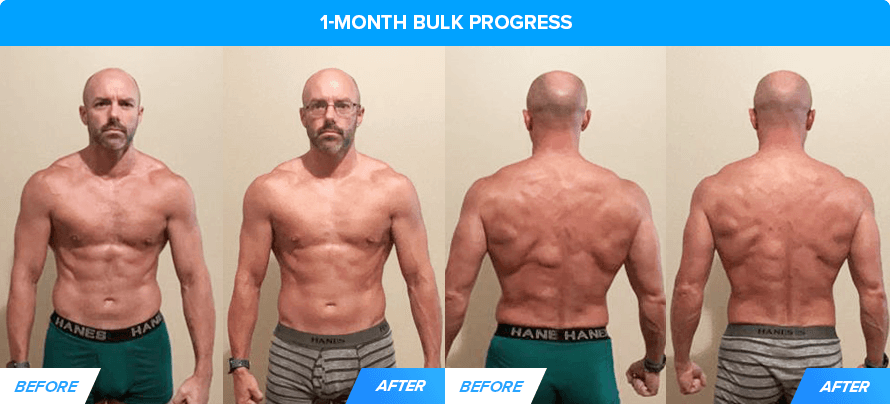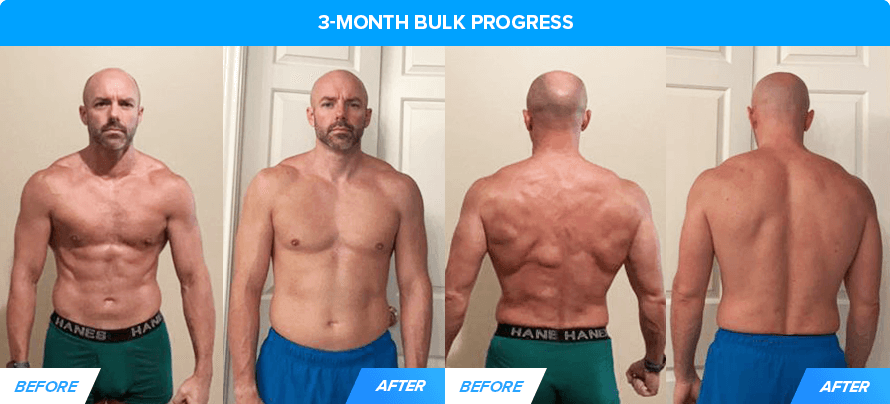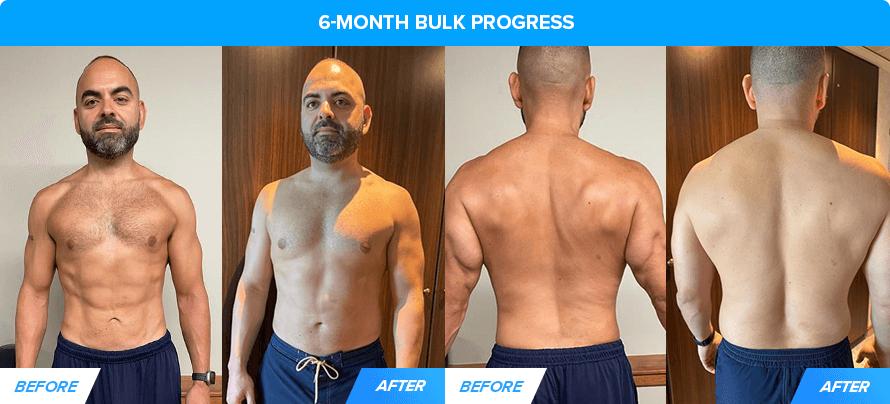A common question among people looking to improve their body composition is, “How long should I bulk for?”
While it seems straightforward, the answer is more nuanced than you might expect, primarily because it depends on various factors, including your starting body fat percentage, goals, preferences, and experience level.
However, most people want the same outcome when they bulk: To build muscle without gaining excess fat. With this in mind, we can establish some general guidelines.
A practical rule of thumb is to bulk until your body fat percentage reaches 15-to-17% for men or 25-to-27% for women.
In this article, you’ll learn why these are usually good cut-off points, discover when to stop bulking earlier or later than this, explore the results you can expect from a 1-month, 3-month, or 6-month bulk, and more.
How Long Should You Bulk For?
There’s no one-size-fits-all answer to how long you should bulk. It depends on the following:
- Goals: If you aim to gain a lot of muscle, you’ll need to bulk longer than someone with more modest goals.
- Experience level: The more seasoned you are with strength training, the longer it takes to build muscle. Thus, while beginners might see rapid gains while bulking, experienced weightlifters typically need to bulk for longer to make progress.
- Starting body fat percentage: If you start bulking with a high body fat percentage, you may need to shorten your bulk to avoid excessive fat gain.
- Surplus size: If you eat too many calories while bulking, a higher percentage of the weight you gain will be fat, not muscle. Thus, if you overindulge while bulking, you may have to curtail your bulk to avoid gaining too much fat.
- Genetics: Some people respond to training faster than others. If you’re a slower responder, you may need to bulk for longer.
Given these variables, setting a strict time limit on bulking isn’t practical—every scenario is simply too different.
For example, a lean beginner might only need to bulk for a few months to gain 5 pounds of muscle, while a more advanced weightlifter with more body fat might take a year or more to gain the same amount while managing their body fat percentage.
A more workable approach is to lean bulk for as long as you can, stopping only when you reach a body fat percentage that feels too high for your preferences.
I’ve helped thousands of people reach their body composition goals, and in my experience, this point is typically around 15-to-17% for men and 25-to-27% for women.
Notice I said “lean bulk for as long as you can,” too.
This is crucial.
If you bulk too quickly by eating too many calories (“dirty bulking”), too much of the weight you gain will be fat, not muscle. As a result, you’ll reach a body fat percentage that’s too high for your liking before gaining the amount of muscle you want, forcing you to stop bulking and halt muscle gain.
When you bulk more conservatively (“lean bulk”), you don’t gain fat as quickly, enabling you to bulk—and build muscle—for longer.
How to Lean Bulk
To lean bulk correctly, you need to calculate your lean bulk calories and macros. I’ll show you exactly how in a moment, but if you’d rather skip the number crunching, take the Legion Diet Quiz.
Answer 9 simple questions, and in just 60 seconds, you’ll know exactly how many calories, how much of each macronutrient, and which foods you should eat to lean bulk successfully.
Take our online diet quiz now to find your new science-based diet.
Or, if you’d prefer to learn the methodology behind the quiz and do the math yourself, here’s what you need to know:
- Lean Bulking Calories: To maximize muscle gain while minimizing fat gain, eat around 110% of your total daily energy expenditure (TDEE). For most people, this means consuming 16-to-18 calories per pound of body weight daily. More specifically:
- If you’re lightly active (1-to-3 hours of exercise or vigorous activity per week), start with 16.
- If you’re moderately active (4-to-6 hours of exercise or vigorous activity per week), go with 17, and then if you aren’t steadily gaining weight and strength, move up to 18.
- If you’re highly active (7+ hours of exercise or vigorous activity per week), use this total daily energy expenditure calculator to determine how many calories you should eat when lean bulking.
- If you’re sedentary (no exercise or vigorous activity), you shouldn’t be lean bulking because extra calories without resistance training just makes you fatter.
- Lean Bulking Macros: In addition to eating enough calories, it’s vital that you balance your fat, carbohydrate, and protein intake (“macros”). Here’s how to calculate your macros for a lean bulk:
- Eat 0.8-to-1 gram of protein per pound of body weight per day.
- Get 20-to-30% of your calories from fat.
- Get the rest of your calories (~40-to-60%) from carbs.
Or, if you’d like a more thorough guide to lean bulking (with an example lean bulk meal plan), check out this article:
How to Lean Bulk Properly
How Long Should a Bulk Last Compared to a Cut?
A bulking-to-cutting ratio of 3:1 works well for most.
For instance, if you bulk for 6 months, spend the following 2 months cutting.
That said, these figures will likely change as you become more experienced with bulking and cutting.
Once you’re good at controlling your calorie intake and can easily maintain a healthy body fat percentage, you may prefer to shorten your cycles of cutting and bulking using mini cuts and bulks.
What Does a Bulk Transformation Look Like?
Most people overestimate how quickly their bodies will change while bulking. They imagine adding slabs of muscle after just a few weeks of eating more.
While new weightlifters may experience rapid muscle gain when they first begin training (“newbie gains”), progress slows significantly after your first 6-to-12 months of lifting.
And that’s why achieving truly impressive results often requires alternating between lean bulking and cutting phases multiple times.
For example, the folks below dramatically changed their bodies on my body transformation coaching program, but it took at least 1 year of bulking and cutting to get there:

For a more realistic perspective, let’s look at some examples of 1-, 3-, and 6-month bulk transformations from people in my body transformation coaching service.
These guys began bulking when they were already in great shape, so they’re perfect for illustrating the results you can expect once you’re beyond your first few months of training. Just bear in mind that during this process, they had the guidance of an experienced coach. Without one, your results may look different.
1-Month Bulk Transformation
Here’s how Jearon’s body changed after 1 month of bulking. While the differences are subtle, you can tell that his entire upper body is slightly fuller in the “after” shot than his “before” picture:

3-Month Bulk Transformation
Jearon continued his bulk and here’s how he progressed after 3 months of bulking. His results are more pronounced in these pictures. In particular, his upper back, pecs and arms are noticeably bigger:

6-Month Bulk Transformation
Eric did 6 months of bulking, and here’s how his body changed. While he clearly gained overall upper body mass, his back—especially his lats—got significantly thicker and wider:

